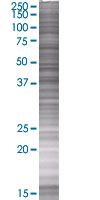Rad51C overexpression 293T lysate (whole cell) (ab94121)
Overview
-
Product name
Rad51C overexpression 293T lysate (whole cell) -
General notes
ab94121 is a 293T cell transfected lysate in which Human Rad51C has been transiently over-expressed using a pCMV-Rad51C plasmid. The lysate is provided in 1X Sample Buffer. Note: For more detailed how the transfected lysate was prepared view preparation notes
-
Tested applications
Suitable for: WBmore details
Properties
-
Mycoplasma free
Yes -
Form
Liquid -
Storage instructions
Shipped on dry ice. Upon delivery aliquot and store at -20ºC. Avoid freeze / thaw cycles. -
Storage buffer
Constituents: 0.01% Bromophenol blue, 2.3% Beta mercaptoethanol, 2% Sodium lauryl sulfate, 0.788% Tris HCl, 10% Glycerol (glycerin, glycerine) -
 Concentration information loading...
Concentration information loading... -
Research areas
-
Background
Function: Essential for the homologous recombination (HR) pathway of DNA repair. Involved in the homologous recombination repair (HRR) pathway of double-stranded DNA breaks arising during DNA replication or induced by DNA-damaging agents. The RAD51B-RAD51C dimer exhibits single-stranded DNA-dependent ATPase activity. The BCDX2 complex binds single-stranded DNA, single-stranded gaps in duplex DNA and specifically to nicks in duplex DNA. Participates in branch migration and Holliday junction resolution and thus is important for processing HR intermediates late in the DNA repair process. Also has an early function in DNA repair in facilitating phosphorylation of the checkpoint kinase CHK2 and thereby transduction of the damage signal, leading to cell cycle arrest and HR activation. Protects RAD51 from ubiquitin-mediated degradation that is enhanced following DNA damage. Plays a role in regulating mitochondrial DNA copy number under conditions of oxidative stress in the presence of RAD51 and XRCC3. Contributes to DNA cross-link resistance, sister chromatid cohesion and genomic stability. Involved in maintaining centrosome number in mitosis. Tissue specificity: Expressed in a variety of tissues, with highest expression in testis, heart muscle, spleen and prostate. Disease: Defects in RAD51C are the cause of Fanconi anemia complementation group O (FANCO) [MIM:613390]. It is a disorder affecting all bone marrow elements and resulting in anemia, leukopenia and thrombopenia. It is associated with cardiac, renal and limb malformations, dermal pigmentary changes, and a predisposition to the development of malignancies. At the cellular level it is associated with hypersensitivity to DNA-damaging agents, chromosomal instability (increased chromosome breakage) and defective DNA repair. Defects in RAD51C are the cause of breast-ovarian cancer familial type 3 (BROVCA3) [MIM:613399]. It is a condition associated with familial predisposition to cancer of the breast and ovaries. Characteristic features in affected families are an early age of onset of breast cancer (often before age 50), increased chance of bilateral cancers (cancer that develop in both breasts, or both ovaries, independently), frequent occurrence of breast cancer among men, increased incidence of tumors of other specific organs, such as the prostate. Similarity: Belongs to the RecA family. RAD51 subfamily.
Images
-
ab94121 at 15μg/lane on an SDS-PAGE gel
-
All lanes : Anti-Rad51C antibody (ab55728) at 1/500 dilution
Lane 1 :Rad51C overexpression 293T lysate (whole cell) (ab94121)
Lane 2 : 293T non-transfected lysate
Lysates/proteins at 25 µg per lane.
Secondary
All lanes : Goat Anti-mouse IgG (H and L) HRP conjugated at 1/2500 dilution








